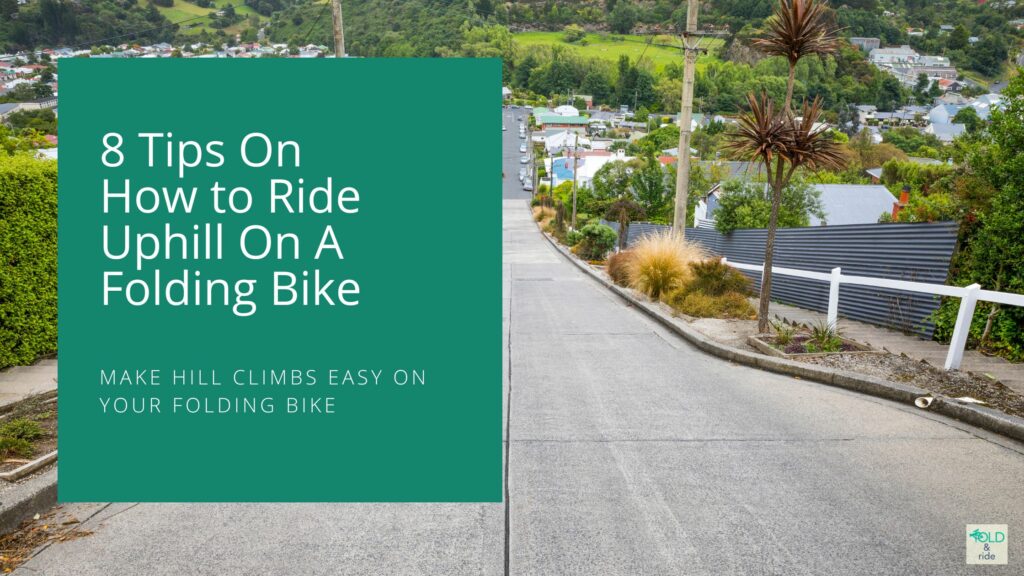Folding bikes are great for commuting and squeezing into train compartments. But what about hills? Many people find that the most challenging part of riding a fold-up bike is tackling gradients.

As an Amazon affiliate, we earn from qualifying purchases.
If you live in a hilly city, or simply have to ride uphill regularly, you’ll soon discover that many fold-up bikes don’t cope well with inclines. Even downhill can be challenging if it’s mostly paved with cobblestones and the like. To help you conquer the hills, here are some tips on how to ride uphill on a folding bike:
Is it hard to ride a folding bike uphill?
Folding bikes can be heavy, and if yours has a small wheel hub (typically 16-inch or 20-inch wheels), you may feel like you’re pushing a bit of a bulldozer. On the other hand, if it’s a light, well-made bike with 26- or 28-inch wheels, you may fly up the hills so fast you’ll have to slow down.
The key to riding a folding bike uphill effectively is to find the right gear and pedal stroke that works for you.
If you have a small-wheel folding bike, start out using a lower gear to give you more oomph. If you have a large-wheel bike, you’ll want to start out in a higher gear to avoid spinning out on the steeper hills.
You may also want to use a lower gear to descend the hills, as the smaller wheels on many large-wheel folding bikes may be less effective.
Can you stand on a folding bike?
If you’re really struggling, you can try standing up on a folding bike. You may be able to get more power by putting your hips into the effort, which can be easier if you’re standing.
However, you’ll probably find it’s not possible to keep pedaling if you’re standing for long periods. This is because you need to keep your hips rotating as you pedal, which is almost impossible to do if you’re standing still.
Another reason not to stand is that your gears will quickly wear out if you’re putting a lot of force on the pedals. Using a lower gear while standing can be helpful, but it can also be hard on your knees to be pushing down a lot while standing.
You may want to practice riding on a flat surface before trying to tackle a long hill while standing.
Find a gear that works for you
Because every gear has a slightly different resistance, you can try out different combinations to find the gear that works for you. You may find that pedaling in an easier gear at a slower speed is better than going for the higher gear and spinning out.
This is especially true if the hill is long and mostly paved with cobblestones. You can also try out a low gear on long, paved descents, as it’s often better to pedal with a low gear than to try to go fast on a higher gear.
Keep in mind, however, that you may also want to change your gear if you encounter different terrain.
For example, riding over a grassy patch can slow you down, while riding on a smoother surface will allow you to go faster.
Use your body weight
It’s especially important to keep your body relaxed when riding uphill. If you’re tensing up, your pedal stroke may be less effective, which means you’ll be pushing harder.
Tensing up also makes your hands grip the handlebars more tightly, which can lead to numb hands.Keep your upper body relaxed, and try to relax your legs as well. You can do this by shifting your weight back so that you’re pushing up with your legs instead of your back muscles.
This can make a big difference when riding a small-wheeled folding bike.If you have to stand, put most of your weight on your back leg so that you’re not pushing too hard with your front leg.
Check your brakes
If you’re riding up a lot of hills, you’re likely to wear out your brakes faster than you might on a less hilly route. You may also find that your brakes are less effective in certain conditions, such as on a steep downhill or wet surface.
If your brakes are rubbing, they’ll wear out faster and be less effective. Therefore, it’s a good idea to check your brakes regularly and make sure they’re not touching your wheels.
If they are rubbing, you may want to consider adjusting them so they don’t touch. Alternatively, you may want to look into getting new brakes that are made for riding on hills.
Be light and use your legs
If you’re riding a heavy, hard-to-pedal folding bike, you may feel like you’re trying to push a boulder up a hill.
To make the ride easier, try to be as light as possible on the bike. Stand up, keep your back straight, and put most of your weight on your back leg.You may also want to shift your weight slightly backward so your foot is not pushing against the pedal as much.
If you’re riding a heavy bike, you may also want to consider shifting to a lower gear.For added power, try pushing up with your legs when you pedal. Lift your knees slightly and push up with your quads, which is the muscles on the front of your thighs.
Don’t push down with your knees; rather, try to keep your feet level while pushing up with your quads.
Try a different pedal position
If you’re having trouble with the pedal position on your folding bike, you may want to experiment with a different position. If you’re having trouble with a small-wheel folding bike, you may want to try sitting slightly farther forward to put more weight on the pedals.
For large-wheel folding bikes, you may want to try sitting farther back so your feet are closer to the pedals.
If you have clipless pedals, you may also be able to move your cleats to a position that is easier for you to use.
Practice before your commute
Before tackling a long hill, you may want to practice riding with a lower gear. Riding with a lower gear will help you get used to riding with a gear that is easier to pedal, which will make it easier to climb.
Alternatively, practice shifting gears on a hill that has a few different gradients. Riding up a hill that has a few different grades will help you get used to shifting gears while you’re actually pedaling up a hill, which is harder than it sounds!
You may also want to practice standing on a hill that you don’t normally ride. Standing up will place more weight on the pedal, which may make it easier to climb.
However, you’ll have to use a lower gear to do so, which will also slow you down.
Steady is fast
When climbing a steep hill, try to go steady and keep your cadence high. You may want to shift to a lower gear to help you pedal more steadily, but be careful not to shift into a gear that is too low, as you may be unable to get back up the hill.
You can also shift your cadence to keep it steady. For example, you may want to pedal in two-four-two-four-two-four-two-four, which can help you keep your cadence steady.
It may also be helpful to shift your posture as you climb a steep hill. Aim to sit up straight, but lean slightly back so that you’re not sitting straight up. This will help you shift your weight back and put more power into your pedals.
Upright position on an incline
If you’re riding on a long, steep hill that is mostly paved, you may want to try an upright position. Riding upright
